
(a)
Interpretation: The acceptable names for the given compounds are to be predicted.
Concept introduction:
• The hydrocarbon is named after the longest carbon chain.
• The parent hydrocarbon containing ester group is named with suffix “ate”.
• The alkyl group bonded to oxygen through single bond forms the first part of the ester and alkyl group bonded to carbonyl group forms the second part.
Answer to Problem 22.38P
The acceptable name of the compound A is
Explanation of Solution
The given compound A is,

Figure 1
The red coloured ball has two bonds. So, this is the oxygen atom. The black coloured atoms have four single bonds. So, these are the carbon atoms. The grey coloured balls have one bond. So, these are the hydrogen atoms. The molecular structure of the compound is,

Figure 2
This compound contains ester group. The alkyl group attached to carbonyl group has longest chain of three carbon atoms with two methyl groups substituted at the second carbon atom. The alkyl group bonded to oxygen through single bond has longest chain of three carbon atoms with one methyl group substituted at the second carbon atom. The acceptable name of the compound is
The given compound B is,

Figure 3
The blue coloured ball has three bonds. So, this is the nitrogen atom. The black coloured atoms have four bonds. So, these are the carbon atoms. The grey coloured balls have one bond. So, these are the hydrogen atoms. The molecular structure of the compound is,
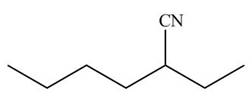
Figure 4
The given compound B contains longest chain of six carbon atoms with ethyl group substituted at the second carbon atom. The acceptable name of the compound is
The acceptable name of the compound A is
(b)
Interpretation: The products formed on treatment of A or B with given reagents: [1]
Concept introduction: The metal hydride reagents are good reducing agents such as
When the esters and nitriles are hydrolyzed to carboxylic acids in acidic medium and in basic medium carboxylate ions are formed.
Grignard reagents are organometallic compounds which are prepared using alkyl halides in the presence of magnesium metal in dry ether. These reagents act as strong nucleophiles and bases.
Answer to Problem 22.38P
The reaction of compound A with given reagents are shown below.
[1]

Figure 5
[2]
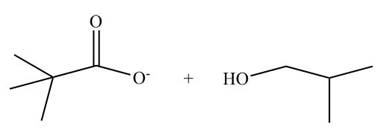
Figure 6
[3]
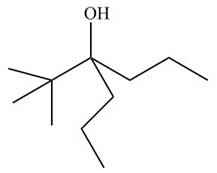
Figure 7
[4]

Figure 8
The reaction of compound B with given reagents are shown below.
[1]

Figure 9
[2]
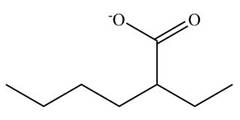
Figure 10
[3]

Figure 11
[4]

Figure 12
Explanation of Solution
The reaction of compound A with given reagents are shown below.
[1]
The ester group undergoes acidic hydrolysis to form alcohol and carboxylic acid as shown below.

Figure 13
The products formed are
[2]
The ester group undergoes basic hydrolysis to form alcohol and carboxylic acid as shown below.

Figure 14
The products formed are
[3]
The given ester compound reacts with excess Grignard reagent followed by hydrolysis to form
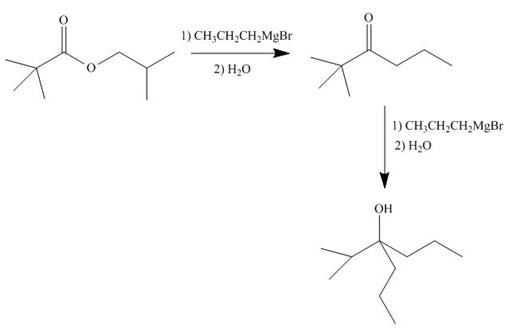
Figure 15
The product formed is form
[4]
In presence of lithium aluminium hydride, the ester group is reduced to two alcohols. The corresponding reaction is shown below.

Figure 16
The products formed are
The reaction of compound B with given reagents are shown below.
[1]
The cyano group undergoes acidic hydrolysis to form carboxylic acid as shown below.

Figure 17
The products formed is
[2]
The cyano group undergoes basic hydrolysis to form carboxylate ion as shown below.

Figure 18
The product formed is
[3]
The nitrile compound reacts with Grignard reagent to form alcohol. The corresponding reaction is shown below.

Figure 19
[4]
In the presence of lithium aluminium hydride, the ester group is reduced to two alcohols. The corresponding reaction is shown below.

Figure 20
The product formed is
The products formed on treatment of A or B with given reagents: [1]
Want to see more full solutions like this?
Chapter 22 Solutions
ORG.CHEMISTRY CONNECT ACCESS>CUSTOM<
- Draw the products formed when p-methylaniline (p-CH3C6H4NH2) is treated with each reagent. a. HCl b. CH3COCl c. (CH3CO)2O d. excess CH3I e. (CH3)2C = O f. CH3COCl, AlCl3 g. CH3CO2H h. NaNO2, HCl i. Part (b), then CH3COCl, AlCl j. CH3CHO, NaBH3CNarrow_forwardOximene and myrcene, two hydrocarbons isolated from alfalfa that have the molecular formula C10H16, both yield 2,6- dimethyloctane when treated with H2 and a Pd catalyst. Ozonolysis of oximene forms (CH3)2C = O, CH2 = O, CH2(CHO)2, and CH3COCHO. Ozonolysis of myrcene yields (CH3)2C = O, CH2 = O, (two equiv), and HCOCH2CH2COCHO. Identify the structures of oximene and myrcene.arrow_forwardDraw the organic product(s) formed upon the addition of HBr to (a) 2-methyl-2-pentene, (b) trans-2-hexene, and (c) 4-methylcyclohexene. How many regioisomers can be formed in each case?arrow_forward
- Ibufenac, a para-disubstituted arene with the structure HO2CCH26H4CH2CH(CH3)2, is a much more potent analgesic than aspirin, but it was never sold commercially because it caused liver toxicity in some clinical trials. Devise a synthesis of ibufenac from benzene and organic halides having fewer than five carbons.arrow_forwardNitromethane is reacted with ethyl prop-2-enoate with EtO-Na+, EtOH 3 equivalents to give the product X(C16). X then reacts with H2/Raney Ni to give the product Y(C14), which in turn reacts with Na to give Z (C12). Indicate which products X, Y and Z are.arrow_forwardThe key step in a reported laboratory synthesis of sativene, a hydrocarbon isolated from the mold Helminthosporium sativum, involves the following base treatment of a keto tosylate. What kind of reaction is occurring? How would you complete the synthesis?arrow_forward
- Account for the fact that treating propenoic acid (acrylic acid) with HCl gives only 3-chloropropanoic acid.arrow_forwarda) Draw two different enol tautomers of 2-methylcyclohexanone. (b) Draw two constitutional isomers that are not tautomers, but contain a C = C and an OH group.arrow_forwardHow could you separate a mixture of the following compounds? The reagents available to you are water, ether, 1.0 M HCl, and 1.0 M NaOH.arrow_forward
- An alkene is treated with OsO4 followed by H2O2. When the resulting diol is treated with HIO4, the only product obtained is an unsubstituted cyclic ketone with molecular formula C6H10O. What is the structure of the alkene?arrow_forwardcould you synthesize isopropyl propyl ether, using isopropyl alcohol as the only carbon-containing reagent?arrow_forward3 b and c) Give the productarrow_forward

 Organic ChemistryChemistryISBN:9781305580350Author:William H. Brown, Brent L. Iverson, Eric Anslyn, Christopher S. FootePublisher:Cengage Learning
Organic ChemistryChemistryISBN:9781305580350Author:William H. Brown, Brent L. Iverson, Eric Anslyn, Christopher S. FootePublisher:Cengage Learning

